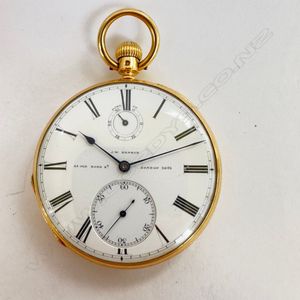18ct Gold Open Face Half-Chronometer Pocket Watch by J. W. Benson
18ct gold open face 'Half-chronometer' pocket watch by J. W. Benson, 25 Old Bond St., London. Number 1091. Fine, signed and numbered white enamel dial, with 0-30 hour up/down dial at XII, sunken subsidiary seconds at VI, black Roman numerals, blued steel hands. Stem wind with depress to wind, hands setting tab lever under bezel at I. Plain case, monogrammed to back, internal 18ct gold cuvette. Signed and numbered 3/4 plate back, helical sprung lever escapement. Total weight 96gm The English term 'Half-chronometer' is, perhaps, a rather grandiose name for what the Americans termed an 'adjusted' watch meaning a watch adjusted for temperature. This does not mean that other watches will not cope adequately with changes in temperature but that the 'Adjusted' or 'Half-chronometer' watch has been rigorously tested at extremes of temperature and adjusted to minimise errors.
You must be a subscriber, and be logged in to view price and dealer details.
Subscribe Now to view actual auction price for this item
When you subscribe, you have the option of setting the currency in which to display prices to $Au, $US, $NZ or Stg.
This item has been sold, and the description, image and price are for reference purposes only.
- Lever Escapement - A lever escapement is a type of escapement mechanism used in mechanical clocks and watches to regulate the timekeeping of the movement. It was invented by British clockmaker Thomas Mudge in the 18th century and is now widely used in modern mechanical timepieces.
The lever escapement consists of three main parts: the escape wheel, the pallet fork, and the lever. The escape wheel is a wheel with teeth that is driven by the clock or watch's main spring or weight. The pallet fork is a two-pronged component that is positioned so that it can engage with the teeth of the escape wheel, and the lever is a small, L-shaped component that is attached to the pallet fork.
When the escape wheel turns, one of its teeth pushes against one of the pallet fork's prongs, causing the fork to pivot. As the pallet fork pivots, it releases the tooth and engages with the next tooth on the opposite side of the escape wheel. At the same time, the lever, which is connected to the pallet fork, rocks back and forth, allowing the escape wheel to turn at a regulated rate.
The lever escapement is prized for its accuracy and reliability and is commonly used in high-end mechanical watches. It allows for precise timekeeping by ensuring that the movement of the watch or clock is regulated and consistent, and its compact size makes it an ideal choice for use in small, portable timepieces. - Bezel - On a clock or watch, the bezel is the metal frame into which the watch or clock glass is fitted. In clocks, the bezel may include a hinge and a flange, in effect a door to the face of the clock. In jewellery the bezel is a band of metal with a projecting lip that holds the gemstone in its setting.
This item has been included into following indexes:
- Benson, J. W. (England)
- pocket watches, case type - open face, gold / gold-plated case 1,381
